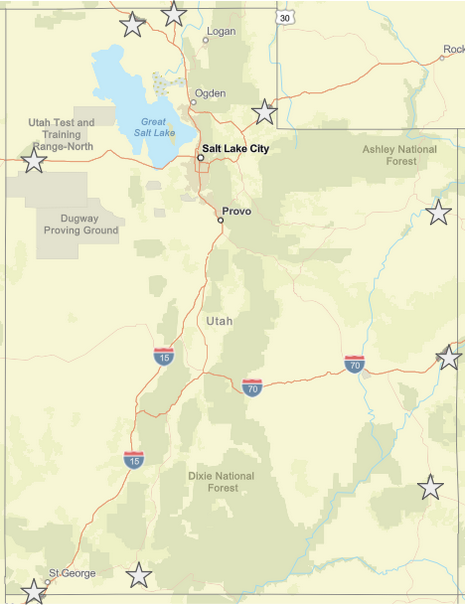Electronic message boards to be used instead to alert motorists of health declaration order. Arriving airline passengers will continue receiving postcards directing them to entry.utah.gov.
Earlier today, the Utah Division of Emergency Management (Twitter, Facebook) discontinued the use of the Wireless Emergency Alert (WEA) system to target alerts at Utah’s state line areas.
State agencies employed the Wireless Emergency Alert system in response to Gov. Gary Herbert’s April 9th executive order requiring anyone entering the state through the Salt Lake City International Airport or major state highway entry points to complete an electronic declaration form, or survey, within three hours of entering the state.
These are extraordinary times, and Utah is taking extraordinary measures. The declaration form requests basic information about health status and travel, and the program serves to inform travelers about public orders and directives in Utah. It does not place any restrictions on travel, and drivers will not be stopped. This is an effort to stay aware of people in Utah who might be at risk for spreading COVID-19.
Travelers in certain groups are exempt, including commercial truck drivers, airline employees, and emergency service providers.

Instead of a Wireless Emergency Alert, the Utah Department of Transportation will deploy variable message signs that indicate motorists should visit entry.utah.gov to complete a health declaration. These signs will display a message similar to the WEA, which was deployed April 11, 12, 13 and 14.
Airline passengers at Salt Lake City International Airport will continue receiving a postcard with a QR code and link to the health declaration form.
This new virus required new thinking and new ideas to combat it. Utah was the first state to attempt to use a WEA to alert motorists entering the state to fill out a health declaration form.
It was important for Utah to try every good idea to stop the spread of COVID-19 in our state.
Joe Dougherty, Utah Division of Emergency Management
Innovations don’t always work out exactly how you hope, however.
We have compassion for the residents who live well outside of the intended alerting area, some of whom were 80 miles away. We heard that some of them received the alert more than 15 times. The system is not supposed to work that way. Phones are supposed to recognize the alert no more than once per alert message.
To those residents in Washington, Uintah and Duchesne counties, and Oneida County, Idaho, we apologize for the inconvenience this caused.
What areas had been intended to receive the alert?

- I-15 at the Arizona border
- US-89 north of Kanab
- US-491/191 at Monticello
- I-70 at the Colorado border
- US-40 at the Colorado border
- I-80 at the Wyoming border
- I-15 at the Idaho border
- I-84 at the Idaho border
- I-80 at the Nevada border
What happens next?
The future for the technology is bright. Our federal partners are working with wireless carriers so that, in the future, alerts will be accurate by a tenth of a mile. We look forward to that day.
We look forward to continued conversations with our federal partners and the wireless carriers as we work toward more precise alerting in the future. In the meantime, the technology is still available for AMBER Alerts and other emergency messages that may need to be sent to wider areas of the state.
On Monday, April 13, 2020, Salt Lake County Emergency Management sent a Wireless Emergency Alert to notify Salt Lake County residents that the county’s stay-at-home order had been extended through May 1. This aligns with Gov. Gary Herbert’s Stay Safe Stay Home directive. Salt Lake County residents should avoid unnecessary travel and monitor CDC and Salt Lake County Health Department websites for the latest information.
The Division of Emergency Management was aware this message would be coming at some point. The timing was uncanny, as it came while a DEM staff member was discussing the discontinuation of the WEA at the state lines. We support Salt Lake County in using this technology to reach as many of its residents as possible.

